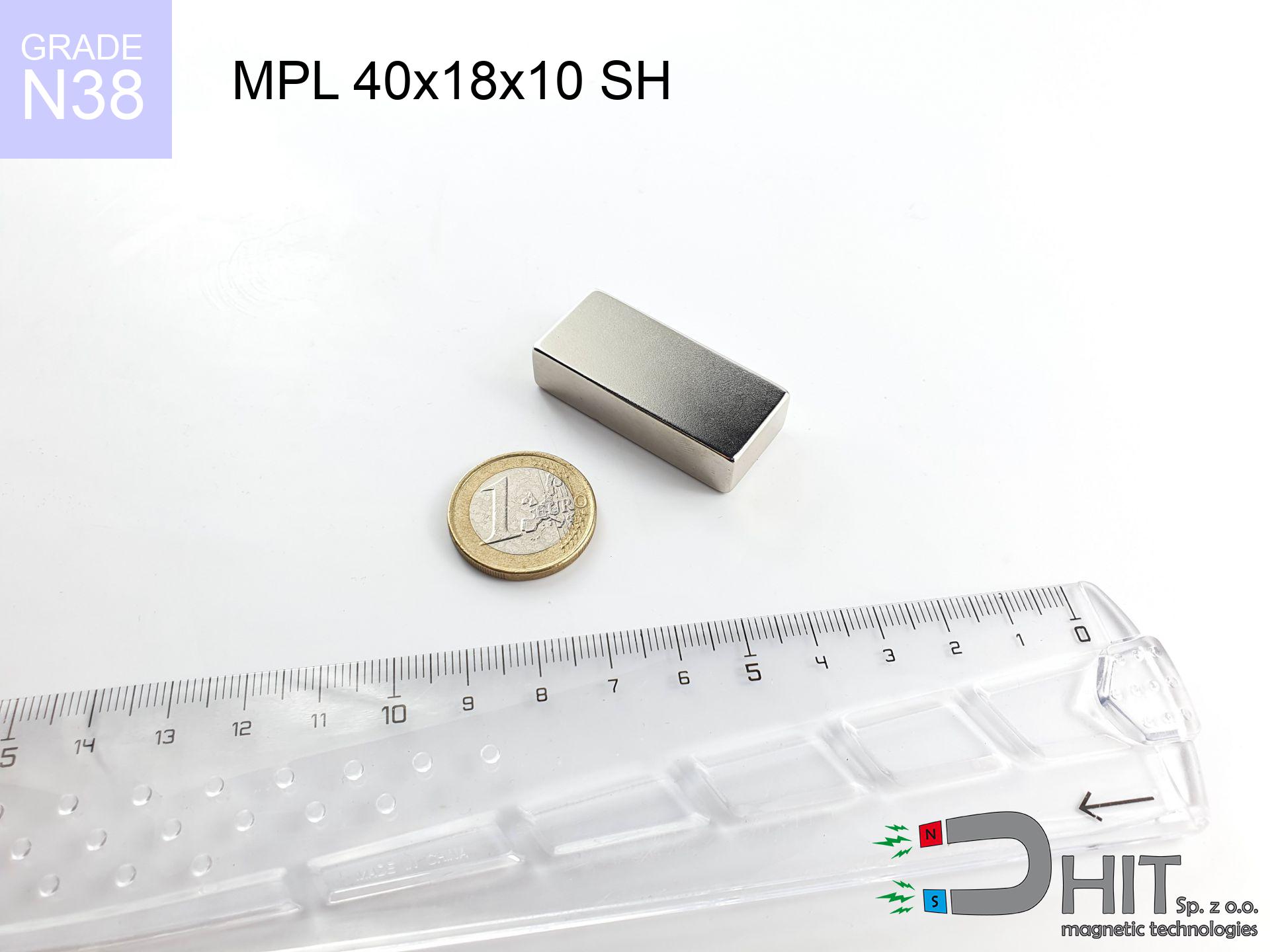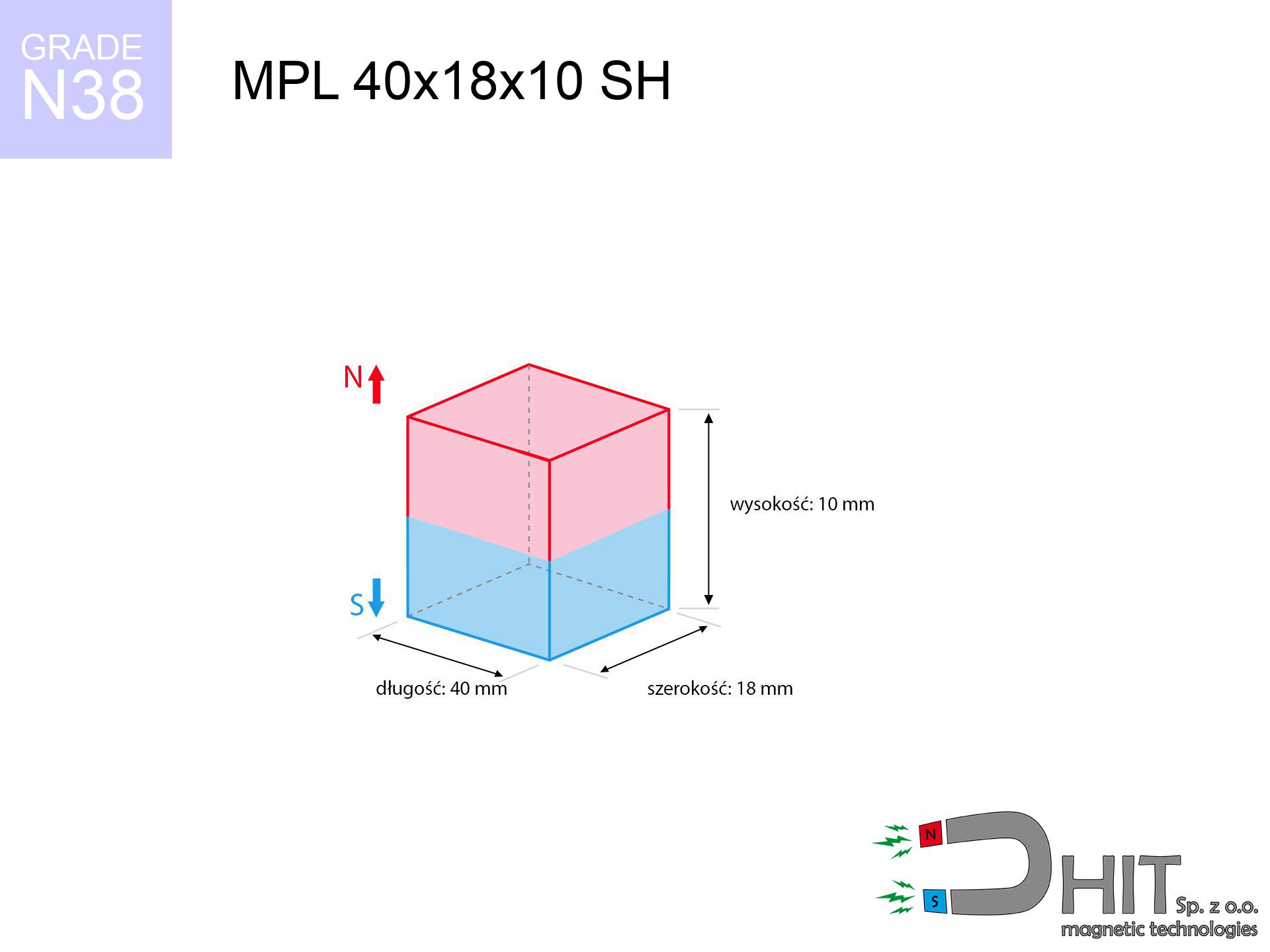MPL 40x18x10 SH / N38 - lamellar magnet
lamellar magnet
Catalog no 020157
GTIN: 5906301811633
length [±0,1 mm]
40 mm
Width [±0,1 mm]
18 mm
Height [±0,1 mm]
10 mm
Weight
54 g
Magnetization Direction
↑ axial
Magnetic Induction
366.66 mT
Coating
[NiCuNi] nickel
33.83 ZŁ with VAT / pcs + price for transport
27.50 ZŁ net + 23% VAT / pcs
bulk discounts:
Need more?Want to negotiate the price?
Call us +48 22 499 98 98 or write via form on the contact page. Test the magnet's power with our power calculator.
Orders placed by 14:00 are shipped the same day.
MPL 40x18x10 SH / N38 - lamellar magnet
Magnetic properties of material N38
Physical properties of NdFeB
Shopping tips
Due to their strength, flat magnets are regularly used in products that need exceptional adhesion.
Typical temperature resistance of flat magnets is 80 °C, but depending on the dimensions, this value grows.
In addition, flat magnets often have different coatings applied to their surfaces, e.g. nickel, gold, or chrome, for enhancing their corrosion resistance.
The magnet with the designation MPL 40x18x10 SH / N38 and a lifting capacity of 0 kg weighing just 54 grams, making it the perfect choice for applications requiring a flat shape.
Contact surface: Due to their flat shape, flat magnets guarantee a greater contact surface with other components, which can be beneficial in applications requiring a stronger magnetic connection.
Technology applications: They are often utilized in different devices, e.g. sensors, stepper motors, or speakers, where the thin and wide shape is crucial for their operation.
Mounting: The flat form's flat shape makes it easier mounting, particularly when it is required to attach the magnet to another surface.
Design flexibility: The flat shape of the magnets permits creators a lot of flexibility in placing them in structures, which can be more difficult with magnets of other shapes.
Stability: In certain applications, the flat base of the flat magnet may provide better stability, minimizing the risk of shifting or rotating. It’s important to keep in mind that the optimal shape of the magnet depends on the specific project and requirements. In certain cases, other shapes, like cylindrical or spherical, may be a better choice.
Magnets have two main poles: north (N) and south (S), which attract each other when they are oppositely oriented. Poles of the same kind, e.g. two north poles, act repelling on each other.
Thanks to this principle of operation, magnets are commonly used in electrical devices, such as motors, speakers, sensors, or magnetic locks. Neodymium magnets stand out with the greatest strength of attraction, making them indispensable for applications requiring strong magnetic fields. Moreover, the strength of a magnet depends on its size and the material it is made of.
It should be noted that high temperatures can weaken the magnet's effect. The Curie temperature is specific to each type of magnet, meaning that once this temperature is exceeded, the magnet stops being magnetic. Additionally, strong magnets can interfere with the operation of devices, such as compasses, magnetic stripe cards and even electronic devices sensitive to magnetic fields. Therefore, it is important to avoid placing magnets near such devices.
Advantages and disadvantages of neodymium magnets NdFeB.
Apart from immense power, neodymium magnets have the following advantages:
- They do not lose strength over time - after about 10 years, their strength decreases by only ~1% (theoretically),
- They are extremely resistant to demagnetization by external magnetic sources,
- By applying a shiny coating of nickel, gold, or silver, the element gains an aesthetic appearance,
- They possess very high magnetic induction on the surface of the magnet,
- Thanks to their high temperature resistance, they can operate (depending on the shape) even at temperatures up to 230°C and above...
- Thanks to the flexibility in shaping and the ability to adapt to specific requirements – neodymium magnets can be produced in a wide range of shapes and sizes, which amplifies their universality in usage.
- Wide application in modern technologies – are utilized in hard drives, electric motors, medical devices or very modern machines.
Disadvantages of neodymium magnets:
- They can break as they are extremely fragile when subjected to a strong impact. If the magnets are exposed to impacts, we recommend using magnets in a metal holder. The steel housing in the form of a holder protects the magnet from impacts and also increases its overall strength,
- Magnets lose their strength due to exposure to high temperatures. In most cases, when the temperature exceeds 80°C, these magnets experience permanent loss in strength (although it is worth noting that this is dependent on the shape and size of the magnet). To avoid this problem, we offer special magnets marked with the [AH] symbol, which exhibit high temperature resistance. They can operate even at temperatures as high as 230°C or more,
- Magnets exposed to a humid environment can corrode. Therefore, when using them outdoors, we suggest using waterproof magnets made of rubber, plastic, or other moisture-resistant materials,
- Limited ability to create threads or complex shapes in the magnet - the use of a housing is recommended - magnetic holder
- Possible danger to health from tiny fragments of magnets pose a threat, in case of ingestion, which is particularly important in the aspect of protecting young children. Furthermore, tiny parts of these magnets are able to hinder the diagnostic process after entering the body.
Be Cautious with Neodymium Magnets
Neodymium magnets should not be near people with pacemakers.
Neodymium magnets generate very strong magnetic fields that can interfere with the operation of a pacemaker. This happens because such devices have a function to deactivate them in a magnetic field.
Neodymium magnets are primarily characterized by their significant internal force. They attract to each other, and any object that comes in their way will be affected.
If joining of neodymium magnets is not under control, then they may crumble and also crack. You can't approach them to each other. At a distance less than 10 cm you should hold them extremely strongly.
Dust and powder from neodymium magnets are flammable.
Avoid drilling or mechanical processing of neodymium magnets. If the magnet is crushed into fine powder or dust, it becomes highly flammable.
Neodymium magnets should not be in the vicinity youngest children.
Not all neodymium magnets are toys, so do not let children play with them. Small magnets pose a serious choking hazard or can attract to each other in the intestines. In such cases, the only solution is to undergo surgery to remove the magnets, and otherwise, it can even lead to death.
Neodymium magnets can demagnetize at high temperatures.
In certain circumstances, Neodymium magnets may experience demagnetization when subjected to high temperatures.
Magnets made of neodymium are extremely fragile, leading to breaking.
Neodymium magnetic are highly fragile, and by joining them in an uncontrolled manner, they will crack. Neodymium magnets are made of metal and coated with a shiny nickel surface, but they are not as hard as steel. At the moment of collision between the magnets, sharp metal fragments can be dispersed in different directions.
Keep neodymium magnets as far away as possible from GPS and smartphones.
Magnetic fields interfere with compasses and magnetometers used in navigation for air and sea transport, as well as internal compasses of smartphones and GPS devices.
Neodymium magnets are the most powerful, most remarkable magnets on the planet, and the surprising force between them can shock you at first.
Please review the information on how to handle neodymium magnets and avoid significant harm to your body, as well as prevent unintentional disruption to the magnets.
The magnet is coated with nickel. Therefore, exercise caution if you have an allergy.
Studies clearly indicate a small percentage of people who suffer from metal allergies such as nickel. An allergic reaction often manifests as skin redness and rash. If you have a nickel allergy, try wearing gloves or avoid direct contact with nickel-plated neodymium magnets.
Under no circumstances should neodymium magnets be placed near a computer HDD, TV, and wallet.
The strong magnetic field generated by neodymium magnets can damage magnetic media such as floppy disks, video tapes, HDDs, credit cards, magnetic ID cards, cassette tapes, or other devices. They can also damage devices like video players, televisions, CRT computer monitors. Remember not to place neodymium magnets close to these electronic devices.
In order to show why neodymium magnets are so dangerous, see the article - How dangerous are powerful neodymium magnets?.




![UMH 20x7x35 [M4] / N38 - magnetic holder with hook UMH 20x7x35 [M4] / N38 - magnetic holder with hook](https://cdn3.dhit.pl/graphics/products/umh-20x7x35-m4-hiz.jpg)
![SM 32x150 [2xM8] / N42 - magnetic separator SM 32x150 [2xM8] / N42 - magnetic separator](https://cdn3.dhit.pl/graphics/products/sm-32x150-2xm8-xus.jpg)
![SM 18x275 [2xM5] / N42 - magnetic separator SM 18x275 [2xM5] / N42 - magnetic separator](https://cdn3.dhit.pl/graphics/products/sm-18x275-2xm5-zep.jpg)


